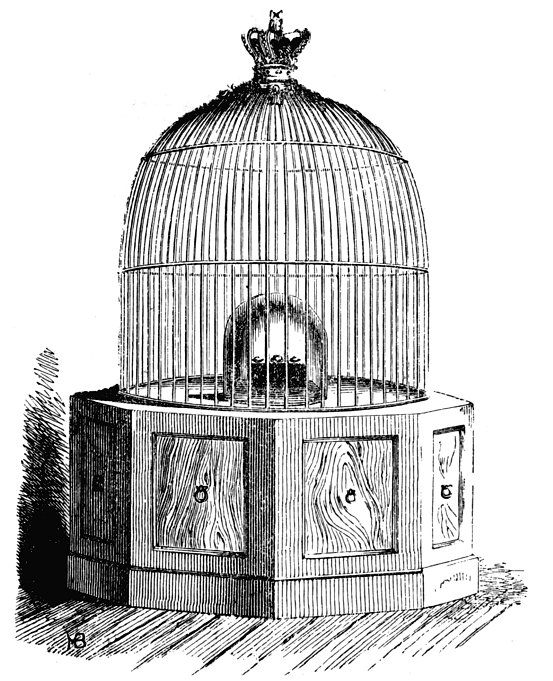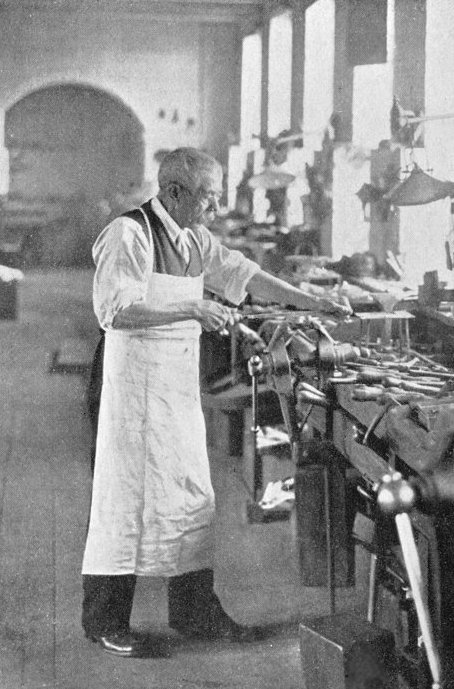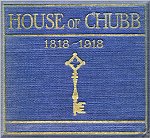|
Anti-Burglar, Fire and Explosive
Devices
The never-ceasing war between the
locksmith and safe engineer on the one hand, and the burglar
and what the old-time journalist termed "the devouring
element" on the other, has been the means of producing
hundreds of devices for adding to the security of valuables,
and countering those dangers which are ever present owing to
the skill of the scientific thief, the ravages of fire, the
carelessness constantly displayed over the custody of keys,
and the neglect of ordinary precautions against fire which
often have such serious results. The latter day burglar is,
in many cases, not only a highly skilled specialist,
supplied with the finest of tools, but he carries out his
work with a coolness, skill and foresight that renders it
difficult to effectually frustrate his efforts. To go fully
into either the devices of the cracksman, or the methods
adopted by the locksmith and safe engineer to combat and
even anticipate them, would afford material for an extensive
volume.
As in the past the skeleton key and the
picklock, which rendered the warded lock vulnerable, caused
the introduction of the tumbler lock with its levers,
barrel, curtain and detector; so the drill, wedge, explosive
and blowpipe have brought into being the safe lock protected
by compound steel plates, the keyless combination lock, the
automatic time lock, the bent-cornered safe, the diagonal
bolt binding the safe door to its frame, compound armour
plate, and many other devices for the defeat of the skilled
burglar.
The latest patent taken out by Messrs.
Chubb protects a clever improvement of the principle
embodied in keyless combination locks used chiefly for the
doors of safes. Much is heard from time to time of
arrangements by which valuables displayed in a shop window
or showcase are lowered at night into a safe or armoured
recess, yet this method was used by Chubb's as early as
1839, and was applied by them to the receptacle made for the
safeguarding of the Koh-i-noor diamond at the Great
Exhibition in 1851. The cage-like structure, which is
illustrated from the original woodcut, was again
requisitioned in recent years for the display of some
notable diamonds of great value, the stones disappearing
into a vault at night.
In "Punch" of June I4th, 1851, appears
a fanciful dialogue between policemen guarding the
Koh-i-noor during the daytime, which ends: "It strikes
seven; the Koh-i-noor sets in its iron safe, and the
policemen depart."
|
|

The cage for the protection of the
Koh-i-noor diamond at the 1851 Exhibition, London. |
|
Freak Contrivances
Such excellent latter day contrivances
as the keyless combination safe lock and the electric alarm
had early prototypes. The present letter lock opening on a
certain word or number is the modern adaptation of a lock
existing in early times. In Beaumont and Fletcher's "The
Noble Gentleman" (1615) reference is made to "a strange lock
that opens with A.M.E.N.": while in some verses
by Carew addressed to May on his
"Comedy of the Heir," there is the following passage:
" . . . As doth a lock that goes with
letters; for, till everyone be known, the lock's as fast as
if you had found none."
In 1827 a locking device was introduced
for use on stagecoach boot doors and similar receptacles, by
which attempts at robbery were announced on an alarm bell
incorporated in the lock; the advertisement stating that
this "notice latch" had been tested on a coach from the
Bolt-in-Tun, Fleet Street, London, "with great satisfaction
to the proprietor." In 1871 this invention appeared again,
the bell-ringing being supplemented by the lighting of a
taper. About 1905 we again meet with it in the form of a
cash box, which on being lifted evinced its dissatisfaction
by the continuous ringing of a bell.
|
|

Antique locks and keys in the Chubb
collection. |
Age does not dim the lustre of these
devices, which are no doubt destined to be perennially
reinvented in various forms to the end of time. Many such
ideas emanate from well meaning folk who have not access to
records of inventions, and having little mechanical
experience are therefore ignorant of the fact that the
contrivances they devise are neither novel nor commercially
practicable.
This is not surprising, for many of the
principles embodied in modern locks and safes are of ancient
origin, and only adapted to modern requirements by the skill
of the experienced craftsman. The bolt work of many modern
safes is, in arrangement, very similar to that of the so
called Armada chests of the Tudor period; while certain
American locks with flat keys are kindred in principle to
ancient Egyptian locks contemporary with the Pyramids.
The
truth of the old saw, "Nothing new under the sun," has been
tardily admitted by many an enthusiastic inventor, who,
after laboriously working out what appears to him to be a
novel idea, has found himself anticipated by a craftsman of
the Middle Ages. |
|
It is almost impossible to say how many
so called patents have been taken out for locks and keys,
probably many thousands in Great Britain alone: and by far
the largest number are worthless from a practical point of
view.
Imitations and Infringements
A search at the Patent Office reveals
the fact that owing to the faulty Patent laws of this
country in bygone days, silly notions, impossible ideas and
duplicated inventions, even devices in vogue in the times of
the Pharaohs, were allowed to be patented at the expense of
the unfortunate inventor, alone benefiting the funds of the
Patent Office. Happily a better system now prevails, in that
a search is undertaken by the Patent Authorities, which may
prevent a man wasting his time and money in protecting an
idea which he fondly, but often wrongly, imagines has never
before occurred to anyone else.
A number of suggested
improvements are annually brought before the experts of
Chubb's Company by people who know little of the technical
side of lock and safe-making, and all that need be said
about these suggestions is that perhaps not one in a hundred
ever comes before the public as a practical and useful
article. The amateur inventor, however, is not easily
discouraged, and Chubb's have hid a wide experience of him,
his weak points and his views on the value of his
inventions.
In 1855 one gentleman offered a lock
whose many virtues appear to have impressed its originator
more than the maker to whom it was offered. He wrote to
Messrs. Chubb as follows: "As you doubtless desire to
possess a lock which possesses perfect security, I may
without apologising call your attention to a lock which I
have planned, which possesses perfect security. It is simple
in construction, strong, not easily deranged by dirt, and
great pressure may be applied to the bolt without injuring
the small works. It can be made to lock without the key; the
key may either move both the bolt and small works or the
small works only; the key has but one motion. Being blind I
have had ample leisure to examine and re-examine every part
of my lock, and I am certain that its security cannot be
surpassed. As I have several inventions which my humble
circumstances do not enable me to patent, I would willingly
sell to you the right to patent my lock for two thousand
pounds sterling. You will oblige me if you let me know at
your earliest leisure whether you will purchase it or not."
The fate of this masterpiece is not
placed on record, and the name of its ultimate purchase, if
any, is not known, but it seems reasonable to surmise that
the various virtues of this mechanical paragon were
discounted by some drawback which failed to appeal to the
instincts of the Chubb experts, and that "the Noes had it."
|
|
Chubb's firm, like other old ones, has
ever been jealous of attempts to make wrongful use of their
name or trademarks. In 1849 we find them petitioning
Parliament. The method then necessary to extend to their
manufactures the protection afforded to cutlery, and citing
the case of a Birmingham locksmith, who, having made use of
their name on his locks and being mulcted in damages and
costs, left the City without going through the formality of
paying either.
That manufacturers had to take stern
measures to protect themselves is indicated by an
advertisement dated February 4th, 1845, in which a defendant
named Thomas Davis writing from Warwick Gaol, intimates that
he is at present there resident at the suit of Messrs.
Chubb, whose name he had placed on locks not of their
manufacture, but who in consideration of the "distressed
state of my wife and family, by reason of my imprisonment,
consented to my discharge.
I do hereby declare that I deeply
regret having ever put their names on my locks, or having
passed off locks of my make for articles of their
manufacture, and I solemnly promise that I will never again,
under any circumstances, commit the same offence." This
declaration is significantly witnessed by "Thomas Maycock,
Turnkey." Human nature in 1845 was much the same as in this
year of grace. |

Harry Inscoe. Who completed 60 years
of service on October 9th, 1918 and is still lock making. |
|
Thomas Davis's prototype of today still
fails to indicate how solicitous he is for the welfare of
his unfortunate wife and family until his misdemeanours have
placed his own person in danger.
The Chubb archives record several
attempts to make improper use of their name in connection
with goods not of their manufacture; but protective
legislation has enabled the Courts to emphatically confirm
Chubb's absolute right to the sole use of their name in
connection with the production of locks and safes.
Perhaps one of the most recent and
interesting latter day decisions in connection with
trademarks was that by which the blanket makers of the
Oxfordshire town of Witney were granted definite legal
confirmation of their ancient right to the exclusive use of
the name of their town as applied to their well known Witney
blankets. Apart from its importance as a trade decision, the
Witney case seems specially pertinent to our present
subject, as the ancient blanket making family of Early,
prominent joint plaintiffs in that action, is closely allied
by family ties with the House of Chubb. |
 |
|
 |
|
 |
Return to
Chapter 1 |
|
Return to
the contents |
|
Proceed to
Chapter 3 |
|